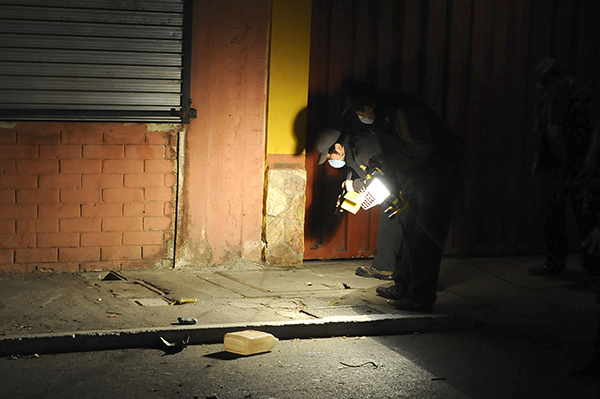On June 25, unidentified assailants shot and killed Álvaro Aceituno López, director of Radio Ilusión in Coatepeque, a town in southeastern Guatemala. López often criticized local government officials when presenting the news and during guest appearances on other programs. But to date, CPJ has been unable to determine if Aceituno was killed for his work as a journalist or if he was a street-crime casualty in a country plagued by gangs, drug traffickers, and one of the highest homicide rates in the world.
It’s not just the Aceituno case that remains unsolved. Confusion reigns over many killings in Guatemala, where numerous journalists are among the victims.
CERIGUA, a Guatemala City press freedom organization that uses different methodology than CPJ to assess journalist killings, recorded the murders of nine journalists so far this year, a jump from 2015 when it put the death toll at three. But due to the slow pace of investigations, authorities have been unable to determine whether any of these murders were work-related.
“This has a huge impact,” said Evelyne Blanck, the director of Centro Civitas, a free speech non-governmental organization in Guatemala City. “It creates a lot of anxiety and leads to self-censorship because journalists don’t know why they are being targeted.”
It also creates confusion over the number of victims.
CPJ investigated all of the journalist killings listed by CERIGUA and, except for the Aceituno case, found no evidence that they were potentially targeted for their work as journalists.
CPJ considers cases “confirmed” only when there is reasonable certainty that journalists were murdered in direct retaliation for their work. When the motive is unclear, but it is possible that journalists were killed because of their work, CPJ classifies these cases as “unconfirmed” and continues to investigate–as in the Aceituno case.
In interviews with CPJ, reporters, editors, and press freedom activists listed numerous reasons for the uncertainty surrounding the killings.
For starters, journalists who face the biggest threats are usually part-time reporters based in small towns far from the capital, said Julia Cardona, an editor at the Guatemala City daily El Periodico. She said that the newspaper pays its correspondents about US$40 per story and that many take on second jobs to make ends meet.
When targeted journalists moonlight in public relations, commerce, city hall, and in other endeavors, however, it becomes harder for authorities to directly link their murders to their journalism, said Carlos Arrazola, editor of the news website Plaza Pública.
“It is very possible that some of these murders are due to common delinquency,” Arrazola told CPJ. “Guatemala has an average of 15 murders per day. There is a culture of violence and a tolerance of violence. People get accustomed to it, which is why the murders of journalists don’t receive much attention.”
But there is the possibility that more sinister forces may be at work. For example, some of the killings recorded by CERIGUA have taken place in areas dominated by drug traffickers who want no scrutiny from journalists. In addition, allegedly corrupt local authorities in remote regions often have little tolerance for watchdog reporting and have been suspected of contracting hit men to go after journalists, Blanck said.
Radio reporter Oswaldo Ical Jom said after he sought information about alleged corruption in the construction of a soccer stadium in the remote town of Chacamán last month, thugs broke into his home and beat him up. Ical, who said he was also briefly kidnapped while reporting in 2014 and works for the radio network Corporación Radial del Norte, has fled to Guatemala City.
Although he has no proof, Ical said he thinks the recent murders are part of a larger campaign by local authorities and organized crime to intimidate the media. “This is a pattern. They don’t respect journalists. They don’t accept criticism. Instead, they threaten you,” Ical said.
Whatever the motives, the killings have produced a climate of fear and uncertainty that provokes self-censorship as journalists seek to avoid putting themselves in greater danger by investigating drug trafficking, government corruption and other sensitive issues, said Ileana Alamilla, the director of CERIGUA.
“Rural areas are much more dangerous for journalists and that leads to more censorship and self-censorship,” Alamilla told reporters last month.
Asked if he pulled his punches when reporting the news, Ical said, “I’ve lost count of how many times that has happened.”
Under pressure from the media, the Guatemala Attorney General’s office created a special unit to investigate crimes against journalists. However, the unit is understaffed and underfunded and has made only limited progress toward solving the killings of journalists, said Arrazola of Plaza Pública.
According to the Guatemala news website Nómada, each of the five prosecutors dedicated to investigating crimes against reporters must handle more than 30 cases. In addition, “there is a lack of experienced officials to take on these issues,” Margarita Castillo, a government consultant told Nómada. “What good is it to have an effective plan on paper if you don’t have the personnel to put it into practice?”
In general, attacks on journalists in remote areas garner little attention. And, of the four journalists CPJ has documented who were murdered in direct retaliation for their work in Guatemala since 1992, partial justice has been achieved in only one case.
“If something happens to a journalist in Guatemala City there is immense pressure from the big media, social networks, and the public to investigate,” Arrazola said. “But in the provinces, not even the media outlets that targeted journalists work for are demanding results.”
Blanck said that a long-discussed proposal for the government to form a national protection plan for threatened journalists has yet to be put into place.
Hilda Pineda, who heads the government’s special unit for crimes against journalists, did not return CPJ’s phone calls seeking comment.
[Reporting from Bogotá]
[EDITOR’S NOTE: The 13th paragraph has been updated to reflect the correct spelling of Chacamán]
